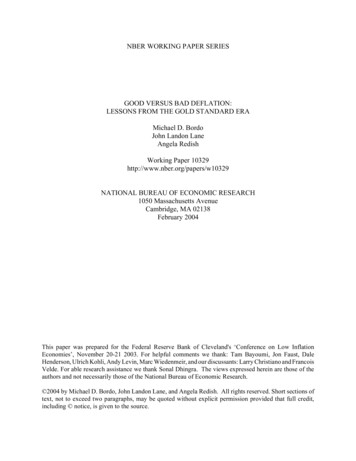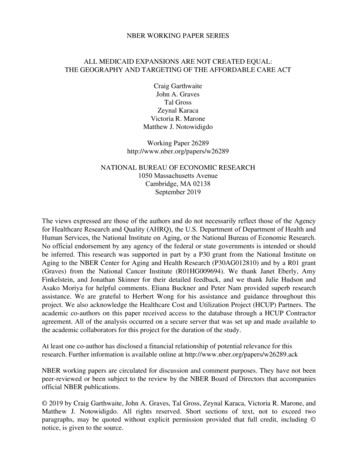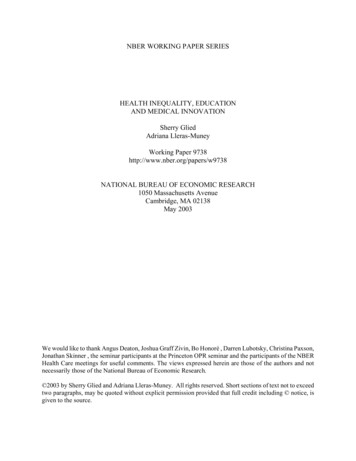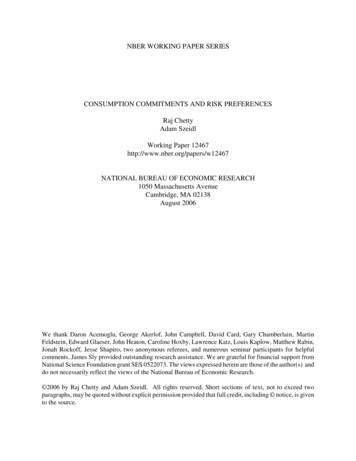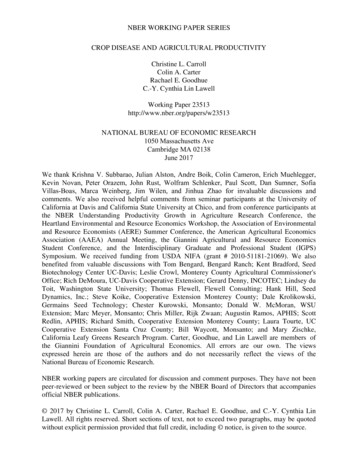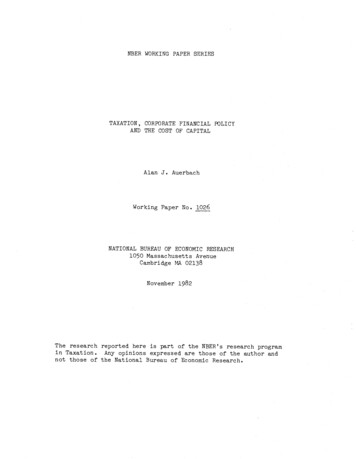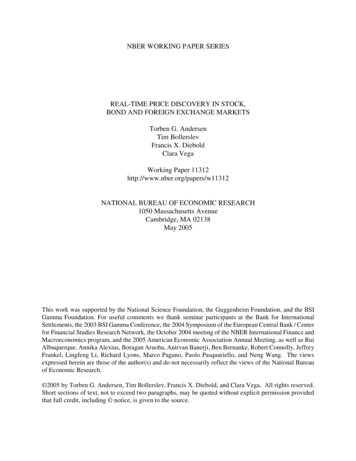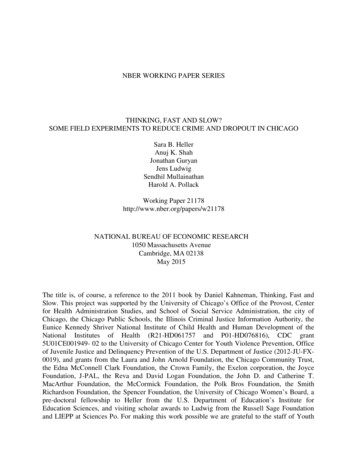
Transcription
NBER WORKING PAPER SERIESLONG-RUN IMPACTS OF SCHOOL DESEGREGATION & SCHOOL QUALITYON ADULT ATTAINMENTSRucker C. JohnsonWorking Paper 16664NATIONAL BUREAU OF ECONOMIC RESEARCH1050 Massachusetts AvenueCambridge, MA 02138January 2011Revised August 2015I wish to thank John Logan (Brown University, American Communities Project) for sharing dataon school desegregation court cases, Sarah Reber for sharing the Office of Civil Rights schooldata, and the PSID staff for access to the confidential restricted-use PSID geocode data. I amgrateful for detailed comments received from David Card, Sheldon Danziger, several anonymousreferees, and seminar participants at the NBER labor studies meetings, IRP Summer Workshop(University of Wisconsin-Madison), UC-Berkeley, University of Chicago, University ofMichigan, Stanford University, Northwestern, NYU, Yale, Duke, University of North Carolina,University of Minnesota, Wellesley College, Chicago Federal Reserve Bank, Russell SageFoundation, ASSA/AEA annual conference, Midwest Economics Association meetings, andAPPAM annual conference. The views expressed herein are those of the author and do notnecessarily reflect the views of the National Bureau of Economic Research. 2011 by Rucker C. Johnson. All rights reserved. Short sections of text, not to exceed twoparagraphs, may be quoted without explicit permission provided that full credit, including notice, is given to the source.
Long-run Impacts of School Desegregation & School Quality on Adult AttainmentsRucker C. JohnsonNBER Working Paper No. 16664January 2011, Revised August 2015JEL No. I00,I21,I28,J15ABSTRACTThis paper investigates the long-run impacts of court-ordered school desegregation on an array ofadult socioeconomic and health outcomes. The study analyzes the life trajectories of children bornbetween 1945 and 1968, and followed through 2013, using the Panel Study of Income Dynamics(PSID). The PSID data are linked with multiple data sources that describe the neighborhoodattributes, school quality resources, and coincident policies that prevailed at the time these childrenwere growing up. I exploit quasi-random variation in the timing of initial court orders, whichgenerated differences in the timing and scope of the implementation of desegregation plans duringthe 1960s, 70s, and 80s. Event study analyses as well as 2SLS and sibling-difference estimatesindicate that school desegregation and the accompanied increases in school quality resulted insignificant improvements in adult attainments for blacks. I find that, for blacks, schooldesegregation significantly increased both educational and occupational attainments, collegequality and adult earnings, reduced the probability of incarceration, and improved adult healthstatus; desegregation had no effects on whites across each of these outcomes. The results suggestthat the mechanisms through which school desegregation led to beneficial adult attainmentoutcomes for blacks include improvement in access to school resources reflected in reductions inclass size and increases in per-pupil spending.Rucker C. JohnsonGoldman School of Public PolicyUniversity of California, Berkeley2607 Hearst AvenueBerkeley, CA 94720-7320and NBERruckerj@berkeley.edu
I. INTRODUCTIONRacial segregation that results in race differences in access to school quality has often been citedas perpetuating inequality in attainment outcomes. Since the landmark 1954 Supreme Court Brown v.Board of Education decision and subsequent court-ordered implementation of school desegregation plansduring the 1960s, 70s and 80s, scholars have investigated the consequences of school desegregation onsocioeconomic attainment outcomes of black children (Clotfelter, 2004; Rivkin & Welch, 2006).However, few large-scale data collection efforts were undertaken to investigate school desegregationprogram effects, particularly on longer-run outcomes. A recent, but growing body of evidence indicatesthat school desegregation improved black students’ educational attainment (Guryan, 2004; Reber, 2010;Hanushek et al., 2009), increased blacks’ subsequent adult incomes (Ashenfelter et al., 2005), anddecreased rates of criminal offending by black youth (Weiner, Lutz, Ludwig, 2009).This paper contributes to the literature a unified evaluation of the long-run impacts of schooldesegregation on adult outcomes across several domains using a more compelling research design andmore comprehensive data. I investigate the extent and mechanisms by which school desegregation andresultant changes in school inputs causally influence subsequent adult socioeconomic and healthoutcomes. The primary difficulty in disentangling the relative importance of childhood family,neighborhood, and school quality factors is isolating variation in school quality characteristics that areunrelated to family and neighborhood factors.This study analyzes the life trajectories of children who were born between 1945 and 1968 andhave been followed through 2013, using the longest-running US nationally-representative longitudinaldata spanning more than four decades. To this data, I link information from multiple data sources thatcontain detailed neighborhood attributes, school quality resources, and coincident policies that prevailedat the time these children were growing up. I also obtained and linked a comprehensive desegregationcase inventory for the years between 1954 and 1990 that contains detailed information for every USschool district that implemented a court-ordered desegregation plan, the year of the initial court order, and1
the type of desegregation court order.1 The implementation of court-ordered school desegregation duringthe childhoods of these birth cohorts provides a unique opportunity to evaluate their long-run impacts.The analysis is presented in two stages. First, I present new evidence of how court-ordered schooldesegregation influenced the quantity and quality of educational inputs received by minority children.Utilizing an event-study research design with both district-level and school-level data, the primaryempirical strategy exploits quasi-random variation in the timing of initial court orders to identify effects. Ifind that desegregation plans were effective in narrowing black-white gaps in per-pupil school spendingand class size and decreasing school segregation. Second, I investigate the long-run impacts of courtordered desegregation on subsequent attainment outcomes, including whether graduated from highschool, years of completed education, college quality, adult earnings and occupational attainment, incomeand poverty status, probability of incarceration, and adult health status. I estimate fully non-parametricevent study models and use the wide variation in the timing of initial court orders and scope ofdesegregation to identify their effects.School desegregation and the accompanied increases in school quality resulted in significantimprovements in adult attainments for blacks. I find that, for blacks, school desegregation significantlyincreased both educational and occupational attainments, college quality and adult earnings, reduced theprobability of incarceration, and improved adult health status; desegregation had no effects on whitesacross each of these outcomes. In order to attempt to identify the potential mechanisms, I analyze the roleof desegregation-induced changes in per-pupil spending and racial school integration, respectively,independent of district-specific trends and other coincident policies. Changes in per-pupil spending andracial integration resultant from court-ordered desegregation are interpreted as markers for the intensity oftreatment. I find that blacks’ adult attainments increased significantly with both the amount of inducedincrease in school spending and the duration of desegregation exposure, with no apparent dose-responsein the amount of racial integration resultant from court orders. Desegregation had no effects on whites’adult outcomes, in neither the duration of exposure nor the intensity of treatment. The results suggest thatthe mechanisms through which school desegregation led to beneficial adult attainment outcomes for2
blacks include improvement in access to school resources reflected in reductions in class size andincreases in per-pupil spending.As an alternative empirical strategy, I use sibling comparisons to identify the effects of schooldesegregation on adult socioeconomic and health outcomes. This identification strategy compares theadult outcomes of individuals who were exposed to integrated schools during childhood with thecorresponding adult outcomes of their siblings (evaluated at the same age) who grew up in the samecommunities but had already reached age 18 prior to desegregation or were exposed to integrated schoolsfor only a limited period of their childhood, conditional on year of birth effects. The pattern of results issimilar across all of the empirical approaches (event study models, 2SLS and sibling fixed effect models),and reveals significant long-run impacts of school desegregation and school quality on a broad range ofadult outcomes. The results are robust to a battery of specification tests, which provides supportiveevidence that the estimates reflect the causal impacts of school desegregation and school quality. Asevidenced herein, the black-white adult socioeconomic and health disparities gap narrowed for the cohortsexposed to integrated schools during childhood.The empirical analysis builds on and extends the literature by investigating (1) non-racialintegration aspects of court-ordered desegregation through its impacts on per-pupil spending; (2) theeffects of court-ordered school desegregation on adult SES and health outcomes while simultaneouslyaccounting for other important coincident policy changes; and (3) the role of childhood school quality incontributing to socioeconomic and racial health disparities in adulthood. By examining life-course effectsof school desegregation across a broad range of subsequent outcomes, I attempt to shed light on themechanisms through which differences in school quality translate into differences in adult outcomes.The remainder of the paper is organized as follows. Section II briefly describes the timing ofcourt-ordered school desegregation. Section III presents the data used. Section IV outlines the empiricalstrategy. Section Va presents results of the effects of school desegregation on school quality inputs (perpupil spending; class size; school segregation). This informs what the typical “treatment” represented forthe average black child. Section Vb presents results of the long-run impacts on adult outcomes.Section VI3
presents conclusions and summary discussion to put the magnitudes in perspective in relation to previousstudies. All appendix material is in the online appendix.II. USING THE TIMING OF COURT-ORDERED DESEGREGATION AS A QUASI-EXPERIMENTIt is hypothesized that school desegregation may have long-run impacts on the adult economicand health status of African Americans through several potential mechanisms: (1) school quality resourceeffects (e.g., the distribution and level of per-pupil spending, class size, teacher quality); (2) peer exposureeffects (e.g., children in classrooms with highly motivated and high-achieving students are likely toperform better due to positive spillover effects on other students in the classroom); and (3) effects onparental, teacher, and community-level expectations of child achievement. The long-run effects of eachhypothesized mechanism operate via their influence on the quality and quantity of educational attainment.I examine the hypothesized primary mechanism: changes in school quality resulting from abrupt shifts inracial school segregation.2An understanding of the causes of the timing of desegregation is critical to the identificationstrategy. Accordingly, Appendix B provides a brief history of school desegregation litigation andimplementation with an eye towards identification issues and demonstrating the validity of the researchdesign—namely, the quasi-random timing of initial court orders. To document the substantial variation inthe timing and intensity of school desegregation efforts, I use a comprehensive desegregation caseinventory compiled by legal scholars for the years between 1954 and 1990 that contains detailedinformation for every US school district that implemented a court-ordered desegregation plan, inconjunction with additional data from Welch and Light (1987) on the dates of major desegregation planimplementation for large urban districts. Figure A1 presents the dates of initial court orders across thecountry among the 868 school districts ever subject to court-mandated desegregation between 1954 and1980. Districts exhibit a great deal of variation in the year in which the initial court order was issued andthe subsequent timing when major desegregation plan implementation actually took place; this variationis evidenced both within and across regions of the country (see Appendix Figures A0-A2).4
Most school districts did not adopt major school desegregation plans until forced to do so bycourt order (or threat of litigation) due to individual cases filed in local Federal court. The importance oflegal precedent caused the NAACP to strategically bring suits first, and foremost, when and where therewas the greatest likelihood of winning, not where the largest potential gains from desegregation could beachieved for a particular local community at a point in time. Enforcement of desegregation did not beginin earnest until the mid-1960s. State and federal dollars proved to be the most effective incentives todesegregate the schools. A critical turning point was the enactment of Title VI of the 1964 Civil RightsAct (CRA) and Title I funds of the 1965 Elementary & Secondary Education Act (ESEA), whichprohibited federal aid to segregated schools and allowed the Justice Department to join suits againstschool districts that were in violation of the Brown vs. Board order to integrate. This Act dramaticallyraised the amount of federal aid to education from a few million to more than one billion dollars a year;and, for the first time, the threat of withholding federal funds became a powerful inducement to complywith federal desegregation orders (Cascio et al., 2010; Holland, 2004). This resulted in a significant dropin the extent of racial school segregation thereafter reinforced by local Federal courts. Thus, there is asharp post-1965 discontinuity in school desegregation.This pattern and discontinuity after 1965 is also evident in the time lag between initial court orderand major desegregation plan implementation, which occurs in the South and non-South (AppendixFigure B6). For initial court orders meted out after 1965, there is immediate implementation (on average,major plan implemented within 1-2 years of initial court order). On the other hand, for initial court ordersmeted out before 1965, there is more than a 10-year delay in implementation of a major plan (i.e., there isa systematic long delay that decreases in years leading up to 1965).Litigation and desegregation plan implementation accelerated substantially between 1964 and1972. For example, only 6 percent of the districts that would eventually undergo court-ordereddesegregation had implemented major plans by 1968 (when the PSID began); by 1972 this rose to over 56percent. It is this period of substantial growth in litigation activity, spurred by landmark court cases likethe 1968 Green decision (which required immediate actions to effectively implement desegregation5
plans), that forms the basis of the research design. The process became highly decentralized with adiverse set of agents that initiated court litigation following the Brown decision, which contributed to theidiosyncratic nature of the timing and location where legal challenges arose that resulted in initial courtorders. Differences across districts in when desegregation court cases were first filed and the length oftime it took these cases to proceed through the judicial system represents a plausibly exogenous source ofidentifying variation in the timing of school desegregation.III. DATAI compiled data on school spending and school segregation, linked them to a comprehensivedatabase of the timing of court-ordered school desegregation, and linked these data to a nationallyrepresentative longitudinal dataset that follows individuals from childhood into adulthood. Educationfunding data come from several sources that are combined to form a panel of per-pupil spending for USschool districts in 1967 and annually from 1970 through 2000.3 School segregation data come from theOffice of Civil Rights (OCR), and are combined to form a panel used to construct school segregationindices that span the period 1968 through 1988. The school segregation and spending data are then linkedto a database of desegregation litigation between 1954 and 2000.The data on longer-run outcomes come from the Panel Study of Income Dynamics (PSID) thatlinks individuals to their census blocks during childhood.4 The sample consists of PSID sample membersborn between 1945 and 1968 who have been followed into adulthood through 2013; these individualswere between the ages of 45 and 67 in 2013. I include all information on them for each wave, 1968 to2013.5 Due to the oversampling of black and low-income families, 45 percent of the sample is black.I match the earliest available childhood residential address to the school district boundaries thatprevailed in 1969 to avoid complications arising from endogenously changing district boundaries overtime. The algorithm is outlined in Appendix A. Each record is merged with data on the timing of courtordered desegregation, data on racial school segregation, student-to-teacher ratios, school spending at theschool district level that correspond with the prevailing levels during their school-age years. Finally, I6
merge in county characteristics and information on other key policy changes during childhood (e.g., thetiming of hospital desegregation, rollout of “War on Poverty” initiatives and expansion of safety netprograms—described in Section IV) from multiple data sources.6 This allows for a rich set of controls.The comprehensive desegregation court case data I use contains an entire case inventory of everyschool district ever subject to court desegregation orders over the 1955-1990 period (AmericanCommunities Project), and major plan implementation dates in large districts (compiled by Welch/Light).Every court case is coded according to whether it involved segregation of students across schools,whether the court required a desegregation remedy, and the main component of the desegregation plan.The combined data from the American Communities Project (Brown University) and Welch/Lightprovide the best available data that have ever been utilized to study this topic for several reasons. First,the year of the initial court order (available for all districts) is plausibly more exogenous than the exactyear in which a major desegregation plan was implemented because opposition groups to integration candelay major desegregation plan implementation by lengthening the court proceedings or by implementinginadequate desegregation plans (supportive evidence on this point is presented in Appendix B). And,court-ordered desegregation by legal mandate is plausibly more exogenous than other more voluntaryforms of desegregation. Second, the date of the initial court order is precisely measured for all districts.Sixty-nine percent of the PSID individuals born between 1945-1968 followed into adulthoodgrew up in a school district that was subject to a desegregation court order sometime between 1954 and1990 (i.e., 9,156 out of 13,246 individuals), with the timing of the court order not necessarily occurringduring their school-age years. Eighty-eight percent of the PSID black individuals born between 19451968 followed into adulthood grew up in a school district that was subject to a desegregation court ordersometime between 1954 and 1990 (i.e., 4,618 out of 5,245 black individuals). The share of individualsexposed to school desegregation orders during childhood increases significantly with birth year over the1945-1970 birth cohorts analyzed in the PSID sample (Appendix Figure B5).After combining information from the aforementioned 5 data sources, the main sample used toanalyze adult attainment outcomes consists of PSID individuals born between 1945-1968 originally from7
school districts that were subject to desegregation court orders sometime between 1954 and 1990; thisincludes 9,156 individuals from 3,702 childhood families, 645 school districts, 448 counties, representing39 different states. I restrict the estimation sample to individuals who grew up in school districts that wereever subject to court-ordered desegregation, since school districts of upbringing that were never undercourt order are arguably too different to provide a credible comparison group. Appendix A lists thesources and years of all data elements. Appendix Table C0 contains sample descriptive statistics forvarious childhood measures by race.Outcomes of interest. The set of school inputs examined include per-pupil spending, student-toteacher ratios, and racial school segregation among students and teachers. The measure of schoolspending during childhood is the average school spending (in real 2000 dollars) during expected schoolage years (ages 5 through 17) in an individual’s childhood school district.7 Similarly, I measure theaverage student-to-teacher ratio during ages 5 through 17. The measures of racial school segregationinclude the average school-age black-white dissimilarity index and black-white exposure index amongboth students and teachers, respectively. The set of adult attainments examined chronologically over thelife cycle include 1) educational outcomes—whether graduated from high school, years of completededucation, college quality (proxied by 25th and 75th percentiles of SAT scores of the freshman class ofcollege attended); 2) labor market and economic status outcomes (all expressed in real 2000 dollars)—occupational attainment (Duncan occupational prestige index), log wages, annual work hours, familyincome, annual incidence of poverty in adulthood (ages 20-50); 3) criminal involvement and incarcerationoutcomes—whether ever incarcerated (jail or prison) and the annual incidence of incarceration inadulthood; and 4) health outcomes—self-assessed general health status and the annual incidence ofproblematic health (ages 20-50). All analyses include men and women with controls for gender, givenwell-known gender differences in labor market, incarceration, and health outcomes. This data is combinedto provide new evidence on the long-run impacts of school desegregation.8
IV. EMPIRICAL APPROACHThe primary empirical strategy uses quasi-random variation in the timing of initial court orders toidentify the effects of desegregation. Systematic variation in the timing of desegregation court orderscould lead to spurious estimates of desegregation impacts if those same school district characteristics areassociated with differential trends in the outcomes of interest. As shown below, the main way I test forthis possibility is to use an event study model, which reveals no significant pre-existing time trends in theoutcomes of interest. The exogeneity of this timing is supported theoretically by the documented legalhistory of school desegregation and by my own empirical examination of the issue. Table B1 also showsthat collectively the bulk of pre-treatment school quality, SES, demographic, and labor market relatedcharacteristics does not significantly (jointly) predict the year of the initial court order (Appendix B). Onthe other hand, I find that districts with a larger minority population, greater per-capita school spending,and smaller proportion of residents with low income are each strongly associated with longer delays inmajor desegregation implementation following the initial court order. These results suggest that thetiming of initial court litigation is more plausibly exogenous than the timing of major desegregation planimplementation. These findings inform the empirical approach used to identify school desegregationimpacts.Point-in-time comparisons of integrated and segregated school systems confound the effect ofdesegregation plans with the effect of factors that influenced their implementation. I match changes inschool inputs and adult attainment outcomes of blacks and whites to the exact timing of court-orderedschool desegregation. Average outcome trends in the years leading up to desegregation are compared torule out competing explanations. As will be shown, the evidence is consistent with the identifyingassumption that the timing of the initial court order is otherwise unrelated to trends in subsequentoutcomes. Evidence of endogenous delays in implementation of major desegregation plans following(exogenous) initial court orders supports the research design’s reliance on the timing of initial court9
orders for identification, instead of directly using the timing of major desegregation plan implementationas prior studies have (discussed below).The first stage of the analysis investigates how court-ordered school desegregation influenced thequantity and quality of educational inputs received by minority children. Following Card and Krueger(1992), I measure school quality as the purchased inputs to a school—per-pupil spending and the studentteacher ratio. Newly compiled school district-level and school-level panel datasets allow this analysis touse the staggered timing of court-ordered school desegregation within an event study analysis (cf.Jacobson, LaLonde and Sullivan, 1993; McCrary, 2007) to quantify desegregation effects on schoolresources. The event study framework compares school district per-pupil spending, student-to-teacherratios, and school segregation levels among both students and teachers in the years immediately aftercourt-ordered desegregation to the levels that prevailed in the years immediately before court orders forall districts that were ever subject to court orders. The second part of the analysis uses the same fully nonparametric event study models to quantify desegregation effects on educational attainment, incarceration,and adult economic and health status outcomes, separately by race. The analysis sample is restricted todistricts that were ever subject to desegregation court orders, since districts that were never subject tocourt orders differ (e.g., on average, have a small number of minority students) and do not provide a validcounterfactual for the time-path of what would have occurred in the absence of desegregation.To motivate the empirical strategy, I describe the policy experiment below. Individuals whoturned 17 years old during the initial year of the desegregation court order in their school district shouldhave completed secondary school by the time reforms were enacted. Such cohorts should be unaffectedby desegregation so I classify them as “unexposed”. In contrast, individuals who turned 16 years old oryounger during the year of the passage of a court-ordered desegregation would likely have been attendingprimary or secondary school when desegregation plans were implemented. I refer to these cohorts as“exposed”. One can estimate the exposure effect on school inputs and adult outcomes for blacks andwhites from a particular district by comparing the change in outcomes between exposed and unexposedbirth cohorts from that district, separately for blacks and whites. To account for any underlying10
differences across birth cohorts, one can use the (race-specific) difference in outcomes across the samebirth cohorts in districts that had not desegregated during that time as a comparison. The difference inoutcomes between exposed and unexposed black cohorts in a treated district minus the difference inoutcomes across the same black birth cohorts in comparison districts yields a Difference-in-Difference(DiD) estimate of the exposure effect on outcomes for blacks from that district. Similarly, one can obtaina DiD estimate of desegregation exposure effects for whites based on differences between exposed andunexposed white cohorts. The key identifying assumption is that the timing of initial court orders isotherwise unrelated to within-district changes in outcomes across birth cohorts. Under this assumption, anadditional test of whether there is a causal effect of school desegregation is whether we witness largerimprovements in school inputs and adult outcomes for blacks that experienced desegregation exposure formore of their school-age years (i.e., a dose-response effect); and likewise, we can examine exposureduration effects for whites.Theoretically, it is hypothesized that for African Americans, attending integrated schools duringone’s elementary school years may result in greater benefits than exposure to integrated schools only laterin the school careers due to three factors: 1) elementary students may have fewer social adjustments thanolder students; 2) early learning begets later learning; and 3) secondary schools are more likely to trackstudents by academic ability (and race), which could reduce benefits of desegregation for minorities. Forthese reasons, we may expect a dose-response effect of school desegregation exposure (and accompaniedimprovements in school quality).I estimate fully non-parametric event study models of the form:(1)Yidb 1 Tr I TT 20idb T1220 Tr I Tidb T Tr I Tidb TT 1T 13 X idb Z db (W1960d b) br gr * b idbrrdwhere i indexes the individual, d the school district, b the year of birth, g the region of birth (defined by 9census division categories), and r the racial group. The variable Tidb is
University of California, Berkeley 2607 Hearst Avenue Berkeley, CA 94720-7320 and NBER ruckerj@berkeley.edu . 1 I. . accounting for other important coincident policy changes; and (3) the role of childhood school quality in . (1987) on the dates of major desegregation plan implementation for large urban districts. Figure A1 presents the .
